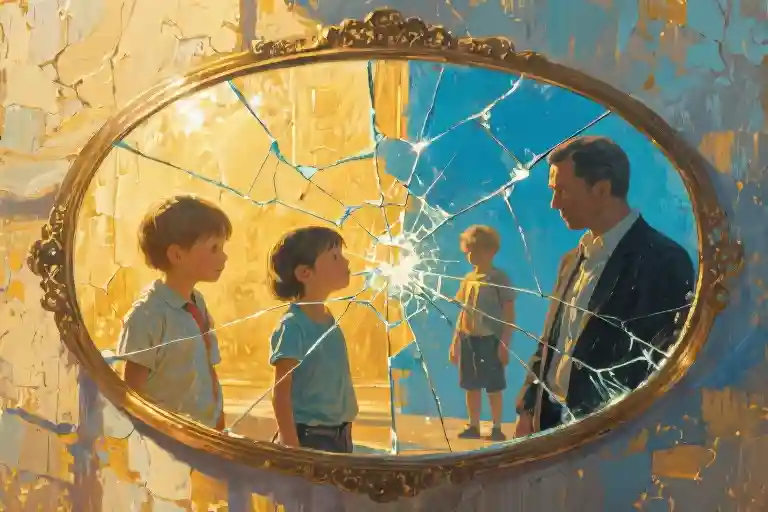There’s a peculiar magic in how the most fleeting things leave the deepest marks. Notice how a stranger’s perfume lingers in an elevator long after they’ve stepped out, how the ghost of a sunset stains your retinas brighter than midday ever could. These vanishing acts hold us captive precisely because they’re ephemeral—whispering the unspoken truth that beauty and loss are twin flames.
We’ve all felt it: that bittersweet ache when a favorite song transports you to a moment already gone, when you clutch someone tighter knowing goodbyes loom. It’s no coincidence these experiences resonate so profoundly. They’re rehearsals for life’s ultimate paradox—the way our brightest sparks gain meaning from their inevitable fading. Like fireflies dazzling against gathering dark, their brilliance depends on the night that will swallow them.
This tension between living and leaving shapes everything precious. The last page of a well-loved book stays with you not despite its finality, but because of it. That final chord of a melody lingers precisely because silence follows. In these miniature goodbyes, we encounter the same quiet magnetism that draws life toward death—not as predator and prey, but as partners in an ancient dance where every step away is secretly a step closer.
Perhaps this explains why certain absences feel more present than presences. The space between a departed loved one’s belongings carries more weight than the objects themselves. A voice memo outlives its speaker not through technological trickery, but because absence amplifies what we choose to remember. These aren’t morbid observations, but revelations about how we’re wired to find meaning in transience—how endings don’t erase stories, but crystallize them.
There’s radical comfort in recognizing this pattern. When we stop fearing the natural arc of all things—the gathering twilight after noon, the quieting of laughter after a perfect evening—we begin seeing each moment as both gift and lesson. The perfume will fade, the song will end, the embrace will loosen. And that’s exactly what makes them sacred.
A Love Letter from Life: The Longest-Prepared Elopement
There’s a quiet understanding between lovers who have spent lifetimes orbiting each other. Death stands at the edge of existence with the patience of folded hands, watching as life stumbles toward it with all the grace of a drunken poet. This isn’t tragedy—it’s the oldest romance in the universe.
We’ve misunderstood death’s nature. It never chases, never demands. Like the horizon holding still while the sun rushes to meet it, death simply exists as life’s most faithful destination. The original text captured this perfectly: “It lets life burn itself out, lets it fight, lets it cling to everything it loves before finally, giving in.” Every heartbeat is another step in this inevitable dance.
Consider how life prepares for this meeting:
- The cherry blossom spends three seasons gathering strength for two weeks of radiant surrender
- Candle flames stretch upward as if trying to memorize the darkness before dissolving into it
- Human lives accumulate stories like currency, saving them for the moment we’ll exchange them for silence
Yet here’s the exquisite paradox—we’re not merely spectators to this cosmic love affair. As the text hints, “we are the unexpected witnesses” to this eternal courtship. Our grief when things end, our tenderness toward fleeting moments—these aren’t failures of understanding, but proof we instinctively recognize the beauty in life’s surrender.
Three layers reveal why this matters:
- The Aesthetics of Longing
That ache when your favorite song ends? The lump in your throat at sunset? These aren’t just reactions—they’re love letters to death’s beauty, written in the ink of human sensation. - The Physics of Burning
Everything that lives consumes itself to continue. We burn memories as fuel, relationships as kindling, dreams as oxygen. The brighter the flame, the sooner the embers cool—and isn’t that the point? - The Algebra of Absence
What remains after loss isn’t emptiness, but the precise shape of what once was. Like perfume lingering after its wearer leaves (that “last drop… longer than their presence”), endings carve presence from absence.
This changes everything. If death isn’t a thief but life’s most devoted lover, then:
- Goodbyes become the punctuation that makes sentences meaningful
- Mortality transforms from countdown to compass
- Each ending becomes evidence we participated in the extraordinary gamble of existence
As the original text whispers: “maybe endings aren’t as cruel as they seem. Maybe they’re just proof that we were here.” The next chapter will show how this truth manifests in our most ordinary moments—the sunsets, songs, and scents that school us in gentle loss.
The Archaeology of Moments: What We Talk About When We Talk About Loss
We collect moments like seashells along the shoreline of our lives—each one glistening with temporary beauty before being pulled back into time’s tide. These fragments of existence gain their luminosity precisely because they cannot last, each ending etching their contours deeper into our memory than their actual duration could ever justify.
Sunsets: Light’s Final Performance
Every evening, the sky stages its grand farewell—streaks of tangerine dissolving into violet, clouds gilded with borrowed light, the sun’s slow descent beneath the horizon’s embrace. Scientists explain this as atmospheric scattering, but our hearts recognize something more profound: nature’s daily rehearsal for surrender.
Reader’s Story (M., 34, Lisbon): “After my father’s terminal diagnosis, we watched 73 sunsets together from his hospital balcony. He called them ‘reverse sunrises’—not an ending but a homecoming. Now when I see particularly vibrant colors, I whisper ‘Good show, Dad’ into the twilight.”
Sunsets teach us the grammar of graceful conclusions. Their transient brilliance mirrors life’s own fleeting radiance—the way a child’s laughter echoes briefly down a hallway, or how summer light lingers golden on skin for just one perfect hour. We don’t mourn the darkness that follows; we celebrate the courage required to blaze so boldly knowing the night must come.
Old Songs: Hauntings in Harmony
Certain melodies function as temporal passports—three notes of a piano intro can collapse decades, transporting us back to bedrooms with mixtapes and promises we thought would last forever. Music becomes the ghost we willingly invite to haunt us, its lyrics gaining new meanings with each replay like palimpsests of the heart.
Reader’s Story (T., 29, Chicago): “The Cranberries’ ‘Linger’ played during our first slow dance at the junior prom. When the news reported Dolores O’Riordan’s death, I dug out that scratchy taffeta dress and danced alone in my kitchen, finally understanding why the song’s title always made her cry.”
These acoustic time capsules reveal a paradox: soundwaves fade instantly, yet their emotional resonance persists longer than physical presence. The crackle of vinyl outlasts the hand that placed the needle; a remembered chorus comforts us long after the voice that sang it has fallen silent. In this way, music becomes death’s most poignant collaborator—transforming absence into something we can still hum along to.
Perfume: Olfactory Epitaphs
Of all our senses, smell forms the most direct neural pathway to memory. A single whiff of jasmine or vetiver can dismantle our carefully constructed adulthood, returning us to grandmother’s vanity or a lover’s collarbone. Perfumes are liquid chronology—their top notes bright with first impressions, heart notes revealing true character, base notes lingering like reluctant goodbyes.
Reader’s Story (R., 41, Melbourne): “My mother wore Shalimar exclusively. After her stroke, I’d spray it on her hospital wristband when she could no longer apply it herself. The nurses would comment on how lovely she smelled, never realizing we were preserving dignity drop by precious drop.”
Fragrance embodies life’s central contradiction—its very purpose is to evaporate. Yet in doing so, it achieves immortality within our neural archives. That final trace clinging to a scarf long after its wearer has gone teaches us this: what seems like disappearance is often just transformation into a form less visible but no less real.
The Paradox of Preservation
These moments—sunset, song, scent—share a sacred function. They are memento vivere (remember to live) rather than memento mori (remember death). By marking time’s passage so exquisitely, they paradoxically suspend it, creating pockets of eternity within life’s relentless forward motion.
We instinctively curate these ephemeral treasures because they offer comfort not despite their transience, but because of it. Like pressing flowers between book pages, we understand their beauty derives from the very fragility we attempt to circumvent. In preserving what cannot last, we participate in life’s most tender conspiracy—pretending, just for a moment, that love might be the exception to entropy’s rules.
The Rhetoric of Death: How Fear Translates into Beauty
Across cultures and centuries, humanity has performed the most extraordinary alchemy—turning the leaden weight of mortality into golden threads of art, ritual, and meaning. What we often label as fear might simply be love wearing its most honest face—a raw acknowledgment that every ending carries the fingerprints of what we cherished.
Mexico’s Day of the Dead: Sugar Skulls and Celebratory Marches
In the cobblestone streets of Oaxaca, death wears a carnival mask. During Día de los Muertos, families craft calaveras—sugar skulls adorned with the names of departed loved ones—not as morbid tokens but as edible love letters. The tradition whispers a radical truth: those who’ve left still have a seat at life’s banquet.
- Marigold pathways: Petals called cempasúchil create golden roads guiding spirits home. Their citrus-sweet scent lingers like a grandmother’s perfume long after her embrace fades.
- Ofrendas as living memoirs: Altars hold the deceased’s favorite mole sauce, well-worn novels, even half-empty tequila bottles—proof that memory thrives in ordinary objects.
This isn’t denial dressed in fiesta colors. It’s the understanding that grief and joy can waltz together, their footsteps tracing the same sacred circle.
Japanese Mono no Aware: Cherry Blossoms and the Ache of Transience
When Kyoto’s sakura petals begin their pink snowfall each spring, locals don’t avert their eyes from the inevitable carpet of wilting blooms. They practice hanami—flower viewing—with particular attentiveness during the fragile days of falling petals. This is mono no aware in action: the bittersweet appreciation of life’s fleeting beauty.
Key manifestations:
- Haiku’s heartbeat: Seventeen syllables capturing a frog’s splash or a winter crow—ephemeral moments fossilized in language.
- Kintsugi repairs: Broken pottery mended with gold lacquer, where fractures become part of the object’s honored history.
- Tea ceremony pauses: The deliberate space between pouring and sipping, honoring what exists only in the threshold.
Unlike Western carpe diem urgency, this philosophy suggests: Don’t just seize the day—let the day seep through you like dye through cloth, knowing the color will fade but the impression remains.
Icelandic Tombstone Poetry: Laughter Carved in Stone
Reykjavik’s cemeteries might be the only places where visitors chuckle at graves. Traditional kvöldvaka (evening wake) customs birthed a unique approach—inscribing witty, self-deprecating epitaphs that mock death’s pretensions:
- “Here lies Jón. Finally, some peace and quiet.”
- “I told you I was ill.” (Spike Milligan’s epitaph, adopted by many Icelanders)
- “Pardon me for not rising.”
This dark humor isn’t defiance but intimacy—like teasing an old friend about their bad habits. When a culture lives with volcanoes and six-month nights, laughter becomes survival equipment.
Threads that Bind: Notice how all three traditions share a secret—they’ve stopped fighting death’s existence and started collaborating with its inevitability. The Mexican skeleton grins, the Japanese petal surrenders to gravity, the Icelander chuckles from the grave. Each converts the terrifying unknown into a familiar character in life’s ongoing story.
Perhaps this is why we instinctively photograph sunsets and save concert tickets—we’re all amateur poets trying to compose our own vernacular of mortality. The next time an old song ambushes your heart with memories, consider: you’re not being haunted. You’re participating in humanity’s oldest art project—learning death’s mother tongue so you can whisper back.
Practicing Your Final Chapter
The Five-Minute Death Meditation
Find a quiet space where you won’t be interrupted. Close your eyes and imagine standing at the edge of a forest during gentle rainfall – the sound of water meeting leaves becomes nature’s white noise, washing away distractions. Breathe in through your nose for four counts, hold for seven, exhale through your mouth for eight. Repeat until your shoulders drop from your ears.
Now visualize your life as a book resting in your palms. Notice its weight, the texture of its cover. With each exhale, pages begin turning slowly backward – not to rewrite your story, but to revisit moments that shaped you. That summer afternoon when sunlight fell through the trees just so. The way your mother’s hands felt when they braided your hair. The first time you realized love could ache.
When you reach the blank pages representing your future, pause. Ask yourself: If these were the final chapters, what scenes would I want written here? Don’t chase answers – let them rise like steam from tea. The meditation ends when the imaginary book closes itself with a soft thud. Open your eyes carrying this awareness: mortality isn’t a threat, but the curator of meaning.
Writing Your Living Eulogy
Traditional obituaries catalogue achievements, but a living eulogy captures how you lived. Below is a template with examples from my personal journal:
Section 1: The Essence
“She wasn’t the type to [common behavior], but she always [distinctive trait].”
Example: “She wasn’t the type to remember birthdays, but she always noticed when someone needed cinnamon in their coffee.”
Section 2: The Gifts
“The world is different because they taught us [lesson] through [action].”
Example: *”The world is different because he taught us patience through watching spiders rebuild webs.”
Section 3: The Echo
“When [sensory trigger], we’ll remember [specific memory].”
Example: *”When autumn leaves crunch underfoot, we’ll remember how she laughed trying to catch them like butterflies.”
Try writing three versions: one for your current self, one for your ideal self, and one for someone you’ve lost. Notice how the exercise shifts from morbid to liberating – death’s beauty lies in its power to clarify what matters.
Integrating the Practice
Keep your living eulogy where you’ll see it daily (taped to your mirror, saved as your phone lock screen). When making decisions, ask: “Would this moment deserve a line in my story?” Not every day needs to be extraordinary, but even ordinary moments can be sacred when framed as finite.
Remember what we learned from the perfume metaphor – longevity isn’t what makes something precious. Like the last drop of fragrance lingering on a scarf, your briefest acts of courage and tenderness may outlast you. That’s the paradox death teaches: by embracing endings, we begin living deliberately.
The Epilogue: Where Fragrances Never Fade
Now you understand—the scent that lingers after the bottle empties, the echo of a laugh caught in an old song, the way golden hour light seems to hold its breath before dissolving. These weren’t disappearances. They were love letters.
That perfume you thought had vanished? It simply completed its journey. Like life, like all things that matter, it wasn’t designed to stay. Its beauty lived in the leaving, in the way it taught your senses to memorize what hands couldn’t hold. This is the secret those who fear endings miss: what dissipates was never truly lost. It becomes the air itself.
So here’s the question that remains, glowing like embers after the fire has burned low: If the ending were guaranteed—not as threat but as promise—how would you love this world today?
Would you:
- Press your cheek against ordinary moments like they were stained glass?
- Stop rationing your joy because you’ve mistaken eternity for a requirement?
- Let your heartbreak be the proof you showed up to the feast, not the reason you left early?
There are no wrong answers. Only living ones.
The page turns blank here, not because the story ends, but because yours continues—in the way you’ll hum that melody tomorrow, in the hug you’ll give like it’s both first and last, in the courage to love things that won’t stay.
After all, death may be life’s oldest love story… but you? You’re the current chapter.





